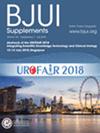Is there a minimum percentage of sarcomatoid component required to affect outcomes of localised renal cell carcinoma?
IF 3.7
2区 医学
Q1 UROLOGY & NEPHROLOGY
引用次数: 0
Abstract
ObjectiveTo evaluate and compare the outcomes of patients with localised renal cell carcinoma (RCC) with and without sarcomatoid features and the impact of this on cancer recurrence and survival.Material and MethodsThe Canadian Kidney Cancer information system database was used to identify patients diagnosed with localised RCC between January 2011 and December 2022. Patients with pT1‐T3, n Nx‐N0N1, M0 stage and documented sarcomatoid status were included. Patients with sarcomatoid RCC were categorised according to the sarcomatoid component percentage (%Sarc). Inverse probability of treatment weighting scores were used to balance the groups. Cox proportional hazards models were used to assess the impact of sarcomatoid status and %Sarc on recurrence‐free and overall survival.ResultsA total of 6660 patients (201 with and 6459 without sarcomatoid features) with non‐metastatic RCC were included. %Sarc data were available in 155 patients, and the median value was 10%. The weighted analysis revealed that the presence of sarcomatoid features was associated with an increased risk of developing metastasis and increased risk of mortality compared to absence of sarcomatoid features. A %Sarc value >10 was associated with an increased risk of developing metastasis and of mortality compared to a %Sarc value ≤10.ConclusionsPatients with a %Sarc >10 have an increased risk of recurrence and mortality. These patients may benefit from a more stringent follow‐up and %Sarc could represent an important criterion in the risk assessment for adjuvant therapy.是否存在影响局部肾细胞癌预后的最小肉瘤样成分百分比?
目的评价和比较具有和不具有肉瘤样特征的局限性肾细胞癌(RCC)患者的预后及其对肿瘤复发和生存的影响。材料和方法使用加拿大肾癌信息系统数据库识别2011年1月至2022年12月诊断为局部肾细胞癌的患者。纳入了pT1‐T3、Nx‐N0N1、M0期和有记录的类肉瘤状态的患者。根据肉瘤样成分百分比(%Sarc)对肉瘤样RCC患者进行分类。使用治疗加权得分的逆概率来平衡各组。Cox比例风险模型用于评估类肉瘤状态和Sarc %对无复发和总生存期的影响。结果共纳入6660例非转移性RCC患者(201例有肉瘤样特征,6459例无肉瘤样特征)。155例患者可获得%Sarc数据,中位数为10%。加权分析显示,与没有肉瘤样特征相比,肉瘤样特征的存在与发生转移的风险增加和死亡风险增加相关。与%Sarc值≤10相比,%Sarc值≤10与发生转移和死亡的风险增加相关。结论%Sarc >;10的患者有较高的复发和死亡风险。这些患者可能受益于更严格的随访,而%Sarc可以作为辅助治疗风险评估的重要标准。
本文章由计算机程序翻译,如有差异,请以英文原文为准。
求助全文
约1分钟内获得全文
求助全文
来源期刊

BJU International
医学-泌尿学与肾脏学
CiteScore
9.10
自引率
4.40%
发文量
262
审稿时长
1 months
期刊介绍:
BJUI is one of the most highly respected medical journals in the world, with a truly international range of published papers and appeal. Every issue gives invaluable practical information in the form of original articles, reviews, comments, surgical education articles, and translational science articles in the field of urology. BJUI employs topical sections, and is in full colour, making it easier to browse or search for something specific.
 求助内容:
求助内容: 应助结果提醒方式:
应助结果提醒方式:


